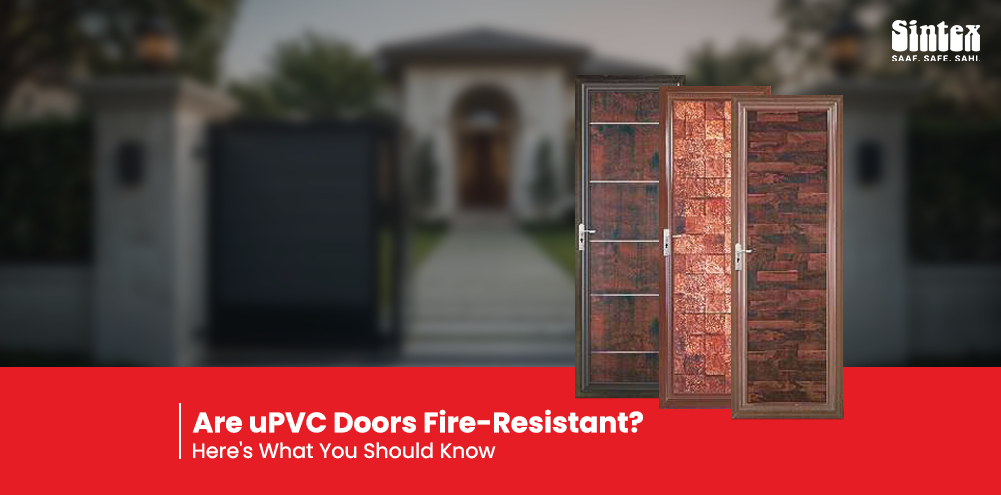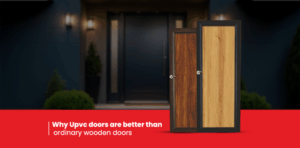Are uPVC Doors Fire-Resistant? Here’s What You Should Know
Share

Table of Contents
This blog consists of an informative guide on whether uPVC doors are fire-resistant and why they are a safe choice for modern homes and buildings. It explains what uPVC is, its fire-retardant properties, and how it slows fire spread instead of fueling it. The blog highlights that not all uPVC doors meet safety standards, stressing the need for certified products like Sintex’s range. It also covers real-world applications (apartments, kitchens, hospitals), a comparison with wooden and metal doors, and debunks common myths.
When choosing doors for your home or project, you consider design, strength, and insulation. But what about fire resistance? If you’re wondering whether uPVC doors are safe in case of fire, you’re not alone. It’s one of the most common questions among homeowners, architects, and builders today.
Let’s clear the confusion and explore what makes modern uPVC doors a smart and safe choice in fire-sensitive environments.
Why Fire Resistance Matters in Modern Doors
Fire safety should never be secondary while building a new house or renovating your home. The risk of fires spreading quickly is present in urban cities where buildings are placed one next to the other or in multi-story apartments. Using fire-resistant uPVC doors may be a matter of life and death, not just an issue of looks.
What Exactly Are uPVC Doors?
uPVC stands for Unplasticized Polyvinyl Chloride. It is a rigid, hard plastic used for manufacturing windows, frames, and doors. It does not warp, crack, or fade easily like traditional materials. Contemporary uPVC doors today are a fusion of style and functionality.
These products, such as Sintex’s Sierra, Doorset, and Indiana range, are manufactured from 100% uPVC virgin material that renders them fire-resistant to normal wear and tear. A main or bathroom PVC door, uPVC provides a flexible and dependable solution.
Fire-Resistant Properties of uPVC
Now on to the question at hand: Are uPVC doors fireproof? Yes, they are fire-retardant in that they slow the spread of fire rather than feed the flame.
Here’s what makes them safer:
- uPVC does not support combustion.
- It extinguishes itself once the fire source is eliminated.
- It is compliant with fire-resistance requirements like BS 476: Part 7 (Class 1) and UL-94 V-0 (flammability).
This gives uPVC door and window fittings those invaluable few minutes in a fire, allowing for safe exit and management of destruction.
Do all uPVC Doors Meet Fire Safety Standards?
Not necessarily. This is where quality matters. Companies like Sintex ensure that their indoor plastic sections are of very high fire-retardant standards. Their uPVC doors are waterproof, termite-proof, anti-fungal, and fire-retardant.
So if you’re shopping for a PVC door for bathroom or a stylish main door, don’t just look at the design—ask for fire certification too.
Real-World Examples: Fire-Retardant uPVC Doors in Use
They’re commonly used in:
- Apartment main doors
- Kitchen entrances
- Public utility rooms
- Bathrooms and wash areas
- Hospital and school buildings
Why? Because they don’t just look good, they’re low maintenance, safe, and long-lasting.
With modern uPVC doors, you don’t need to sacrifice beauty for safety.
Comparison Table: uPVC vs Other Door Materials
| Feature | uPVC Doors | Wooden Doors | Metal Doors |
| Fire Resistance | Fire-Retardant | Flammable | Heat-Conductive |
| Termite Proof | Yes | No | Yes |
| Maintenance | Low | High | Medium |
| Waterproof | Yes | No | Yes |
| Design Options | High | High | Low |
| Corrosion Issues | None | None | Yes (in moisture) |
| Ideal for Bathrooms | Yes (PVC door) | No | No |
Common Myths About uPVC and Fire
Myth 1: Plastics all burn so easily
Fact: All plastics are not created equal. uPVC is fire-resistant.
Myth 2: Fire-resistant doors are very expensive
Truth: Costly, but saves money in the long term as they require low maintenance.
Myth 3: uPVC doors are tacky-looking
Truth: With digital prints and wood-finish appearances, contemporary uPVC doors can be as fashionable as wooden doors.
Final Thoughts
If fire safety is an issue (which it ought to be), uPVC doors are worth considering. They offer a contemporary look with functionality and, most importantly, security. Be it a plastic panel for a bedroom door or a PVC door for the bathroom, you can be sure this material will be termite-, fungus-, fire-, and waterproof.
And the great news? You don’t have to sacrifice either appearance or durability. With options such as digitally printed matte-finish boards and termite-resistant cores, uPVC doors and windows belong to the best no-compromise territory.
If you’re looking for doors that are stylish, sleek, waterproof, and fire-retardant, you’ve come to the right place. uPVC doors check all the boxes. They’re not just another piece of plastic but a bright, modern solution for today’s safety-conscious homes and buildings.
FAQs
No. They are fire-retardant, i.e., they slow the spread of fire but are not fireproof.
Yes. Being fire-retardant, newly made uPVC doors are safer for such use.
Well-made uPVC doors meet safety standards that restrict toxic emissions during a fire.

